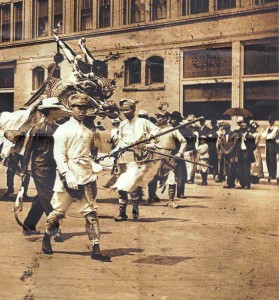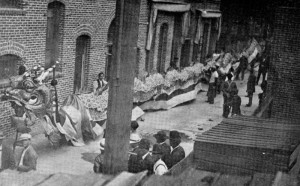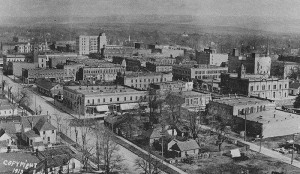Welcome to the Walla Walla’s Chinatown (1860’s – 1940’s) History Website
Walla Walla’s Chinese Community
The first Chinese came to Walla Walla and the Pacific Northwest as part of the Idaho gold rush of the 1860’s. Walla Walla was a major “jumping-off” place for men on their way to the mines, and was also a haven for those who came down from the mines for the winter.
Most of the Chinese were from the Toishan district in the province of Guangdong in Southern China, an area with an impoverished population near a seaport where foreign trade had been established. The local textile industry there had been devastated by the importation of cotton textiles from Great Britain. Many small farmers had been forced off the land, and military conflicts had resulted in upheavals in which emigration often seemed the only alternative.
After the Idaho mining boom died down, the miners moved to work on the railroads or other pursuits. Construction on the Walla Walla and Columbia River Railroad got underway in 1871 with several groups of Chinese grading the line. Upon completion of the WW&CRR, many Chinese laborers settled in Walla Walla resulting in a large increase in the Chinese population here.
During the 1880’s, Walla Walla experienced another wave of immigration from China, Those who settled in Walla Walla at that time were generally small businessmen, domestic workers, and truck farmers. Chinese enterprises included laundries, dry goods stores, restaurants, and medicine shops. In 1882, for example, Walla Walla had nine Chinese laundries; in 1907, Chinese businesses included ten specializing in Chinese merchandise, two druggists, one grocer, six laundries, one medicine manufacturer, and three restaurants.
In addition, there were twenty-five Chinese truck gardens, each employing between eight and nine Chinese. Because they could not legally own land in the United States, the number of Chinese farmers in Walla Walla began to dwindle after 1920, when large numbers of Italian immigrants moved into the valley and began buying land to farm themselves, which the Chinese could only rent.
There have been conflicting reports of the size of the Chinese population in Walla Walla. One source described it as one in seven in 1880, a second as between 600-800 in the 1880’s, and another “as many as 5,000” during the same period. In 1907, it is reported to have been 1250, although only 403 Chinese were registered by the U.S. census in 1900, which dropped to 197 by the official 1910 census. In any event, the Chinese population of Walla Walla has generally been regarded as the largest of any city in Washington State east of the Cascades.
Two Chinatowns
As their population grew steadily from the mid-1860’s until its peak in the 1880’s, the Chinese in Walla Walla tended to migrate to a centralized neighborhood. The first Chinatown in Walla Walla was centered around the Oriental Hotel built in 1867, including the area along Alder and adjoining streets from approximately Colville to Third.
The first Chinese resident was Hen Lee, who opened a laundry in1861 in a log building previously used by Dorsey Baker as a store behind what later became Baker Boyer Bank on Second Avenue. A variety of other Chinese businesses and residences were located nearby, including a store on the northwest corner of First & Alder, a laundry on the northeast corner of Colville & Alder, two cabins housing a barber shop and living quarters south of Alder on the east side of Colville, as well as some two-story buildings on the north side of Alder, between Second and Third with shops below and living quarters above.
The fire of 1887 destroyed this area as well as much of the rest of the downtown. Most of the Chinese population eventually moved to a variety of locations along Rose and adjoining streets between Second and Sixth.
In 1911, prominent members of the Chinese community built the Pacific Enterprise Building at the corner of Fifth & Rose, where it is reported that ninety percent of the Chinese population of Walla Walla lived the early part of the 20th century. The structure became known locally as “the Chinese Building,” and housed a variety of commercial businesses on the street level including laundries and Chinese medicine shops, as well as numerous apartments on the upper level. The Pacific Enterprise Corporation functioned as a form of quasi-government that set rules and regulations, resolved differences between Chinese, cared for the needy and infirm, and acted as liaison with the outside community.
In 1947, the Pacific Enterprise Building was purchased by a local non-Chinese businessman, who closed the residential portion, forcing approximately ninety Chinese inhabitants to find housing among the general population. On February 9, 1947, the Walla Walla Union-Bulletin reported, “…By the end of the year, Chinatown, as modern people know it will be no more. Buildings in the colony on Rose and Fifth and Sixth have been sold, and the exodus of occupants to China will begin February 15. Before the year is ended about 50 will have left.”
The majority of the Chinese in Walla Walla in 1947 had come to the United States as young men in search of adventure and wealth and hadn’t intended to stay, so they hadn’t set down roots or married. When the Chinese Building was sold, even though they had aged here, very few felt they had any alternative but to return to China. However, a small community of younger Chinese who had formed families has remained here, and has integrated into our general population.
With the razing of the Chinese Building in 1962, the contents of the building were donated to the Museum of Man at Whitman College, though relatively little was left to remind Walla Wallans of the once-thriving Chinese community.
Walla Walla’s Final Chinatown
Walla Walla’s final Chinatown was located along Rose and adjoining streets, between Third & Sixth.
In the historical photo of Chinatown above, the upper left hand corner shows the Walla Walla City Hall built in 1908 next to the city’s fire station. Prior to their construction, the following Chinese businesses were located there:
- Charles Ong, Chinese Restaurant,
- Quing Mow Luong & Co, Chinese Merchandise
- Hong Chong Wo Co, Chinese Merchandise
- Kwong Wah Sang & Co, Chinese Merchandise
- Kee Sang Tong, Chinese Merchandise.
Kwong Chung Sing Co., owner Charles Tung, was located on the northwest corner of the City Hall block at Fourth & Rose. The two story Bing Kong Bow Leoung Chinese Lodge Building is shown on the southwest corner of the City Hall block.
On the northwest corner of the next block at Fifth & Rose is the Pacific Enterprise Building. Several Chinese residences are on the south side of the next block as well as on the north side of Rose.
–Information & photo sources for this pamphlet include Weaving the Threads of Our Cultural Heritage: Immigrant Expriences in the WW Valley by Stefanie Marie Starkovich, WW: A Town Built to be a City by Robert A. Bennett, and A Brief History of WW’s Chinese Population by Ashley M. Morton, Ft. WW Museum, 2014.
Walla Walla 2020 Historic Research & Plaque Project
Information on the Walla Walla 2020 Historic Research & Plaque Project is available here or by calling 509-522-0399.
Chinatown History Panel
Additional Resources
Information sources for this page include:
Weaving the Threads of Our Cultural Heritage: Immigrant Experiences in the Walla Walla Valley by Stefanie Marie Stakovich
Walla Walla: A Town Built to be a City by Robert A. Bennett
A Brief History of WW’s Chinese Population by Ashley M. Morton, Ft. WW Museum, 2014.



